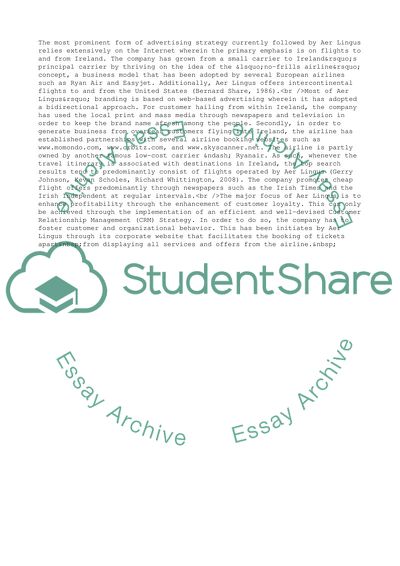Cite this document
(Operation and Communication Plan of Aer Lingus Essay Example | Topics and Well Written Essays - 1500 words, n.d.)
Operation and Communication Plan of Aer Lingus Essay Example | Topics and Well Written Essays - 1500 words. https://studentshare.org/business/1551447-to-analyse-present-promotional-mix-and-develop-a-marketing-and-communication-plan-for-the-client-to-raise-their-brand-awareness-andor-increase-customer-numbers
Operation and Communication Plan of Aer Lingus Essay Example | Topics and Well Written Essays - 1500 words. https://studentshare.org/business/1551447-to-analyse-present-promotional-mix-and-develop-a-marketing-and-communication-plan-for-the-client-to-raise-their-brand-awareness-andor-increase-customer-numbers
(Operation and Communication Plan of Aer Lingus Essay Example | Topics and Well Written Essays - 1500 Words)
Operation and Communication Plan of Aer Lingus Essay Example | Topics and Well Written Essays - 1500 Words. https://studentshare.org/business/1551447-to-analyse-present-promotional-mix-and-develop-a-marketing-and-communication-plan-for-the-client-to-raise-their-brand-awareness-andor-increase-customer-numbers.
Operation and Communication Plan of Aer Lingus Essay Example | Topics and Well Written Essays - 1500 Words. https://studentshare.org/business/1551447-to-analyse-present-promotional-mix-and-develop-a-marketing-and-communication-plan-for-the-client-to-raise-their-brand-awareness-andor-increase-customer-numbers.
“Operation and Communication Plan of Aer Lingus Essay Example | Topics and Well Written Essays - 1500 Words”. https://studentshare.org/business/1551447-to-analyse-present-promotional-mix-and-develop-a-marketing-and-communication-plan-for-the-client-to-raise-their-brand-awareness-andor-increase-customer-numbers.


